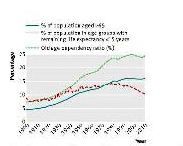Today we review a paper about aging and the implications of using a fixed age, such as 65, to indicate when to worry about “old age” diseases, particularly those such as heart and lung diseases that are aggravated by air pollution. The authors contend that the important statistic to use is the years of remaining life expectancy when the average life expectancy in the UK has increased by 34 years, thus moving the yard stick from the pension age of 65 to later. Over time improvements in medical technology and, indirectly in air quality in some places, seniors are living longer which has increased the size of the older generation, while growing obesity has resulted in earlier occurrence of diabetes with negative impacts on life expectancy. It is clear that the dynamics that affect health of the elderly has changed.

Key Quotes:
“For the first time, there are now more people over the age of 65 in the United Kingdom than there are children under 15 years. Over the past century, the proportion of over 65s has grown from about one in 20 to around one in six.”
“the old age dependency ratio. It takes the number of people who have reached the state pension age and divides it by the number of working age (16-64 years) adults in order to estimate the proportion of older people relative to those who pay for them.”
“Since the main factor behind the ageing population is increasing life expectancy, age is a poor measure of its burden…We can best capture this changing importance of age by realising that the age of a population comprises two components: the years lived of its members (their ages) and their years left (remaining life expectancies).”
“In aggregate terms, the population of 2009, despite being much older as measured by years lived, was nevertheless younger than that of 1900 in terms of years left.[39 more years]”
“if we define the dependent older population as people with a remaining life expectancy of ≤15 years, the trend is different…from the late 1970s improvements in old age mortality have reversed the rise in the proportion of the population with low life expectancies.”
“We should not assume that population ageing itself will strain health and social care systems. Demand for services will rise but continue to be driven by other factors, chiefly progress in medical knowledge and technology, but also the increasing complexity of comorbid age related conditions.”
“Ageing related diseases like osteoarthritis are predicted to increase and start at a younger age. This may not only result in an increased risk of cardiovascular and other chronic diseases, it also suggests that the ageing process can speed up as well as slow down, with obvious implications for public health policy.








No comments:
Post a Comment